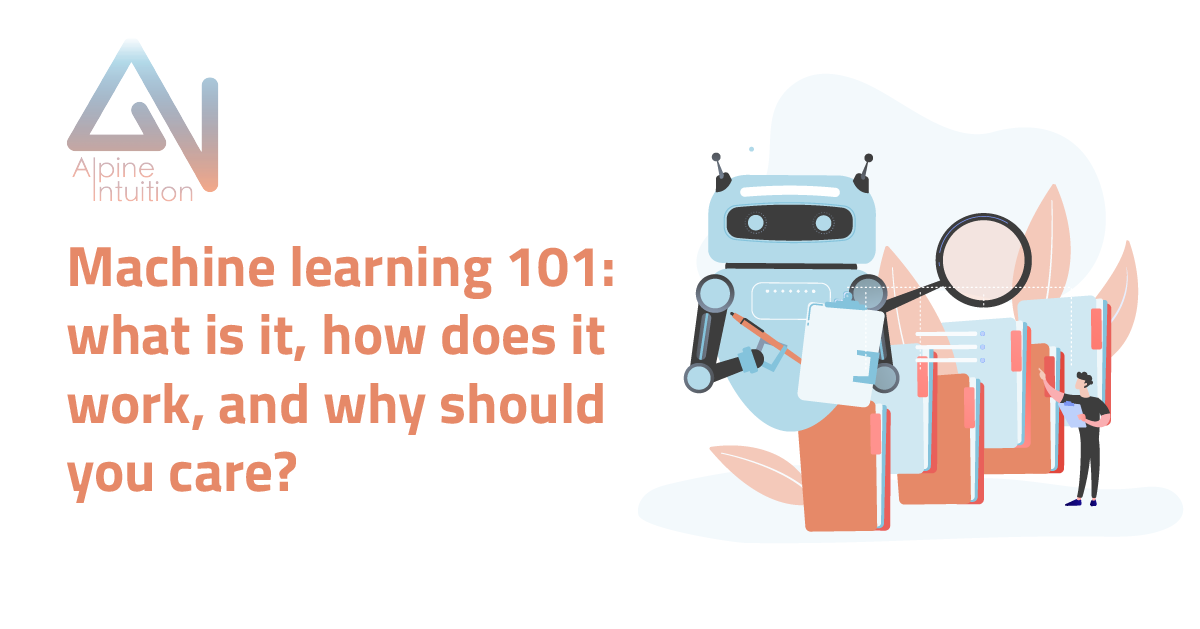
Ever binge-watched a series Netflix suggested for you, asked Siri for help, or fired up Google Maps?
You might not have realised it, but you’ve used machine learning.
But what is machine learning, exactly? How does it work? And which are the areas where it has the biggest potential?
Read on for the answers to all your burning questions.
So what is machine learning, anyway?
Machine learning enables computers to learn from experience. Just as humans can improve their abilities through trial and error, machine learning makes it possible for computers to produce more accurate outputs over time, without any additional input from humans.
Machine learning and AI — artificial intelligence — are sometimes used interchangeably, but they’re two different things.
Artificial intelligence can be loosely interpreted to mean incorporating human intelligence to any machine or electronic device to enable it to think, learn, and adapt to new situations.
Machine learning, on the other hand, is the most widely used application of AI: it enables machines to learn by themselves using provided data to make accurate predictions. Essentially this means it learns new things and gets better at what it does.
How does machine learning work?
Machine learning works by identifying patterns in large volumes of data. Algorithms convert the data into keywords that computers can understand. This allows the computers to learn in much the same way humans do — by ‘reading’ that data and drawing inferences from it.
There are four main types of machine learning processes:
- Supervised
- Semi-supervised
- Unsupervised
- Reinforcement
Supervised machine learning
In supervised machine learning, human trainers give the computer a pre-labelled data-set, known as a training set. The computer goes through the data and compares its results to what the trainers have supplied. This allows it to gauge accuracy and learn from mistakes, so it can make better decisions in future.
Imagine you were designing a recommendation engine — a mechanism that suggests what you might enjoy — for a music app like Spotify.
Supervised machine learning would look something like this:
- First, you’d make a list of your favourite musicians
- Next, the computer would analyse your list to identify their unique characteristics. In our example, it would look at data points like what genre of music your favourite musicians play, and which decade and country they’re from. So if you’re into Abba, for example, the computer would note you’re into 70s Swedish disco
- Lastly, the computer will use those data points to make a list of musicians you might also like
In supervised training, the goal would be for the computer to list the same musicians in the training set. If it does recommend them, the decision-making process is correct and gets confirmed.
But if the computer recommends Justin Beiber or Celine Dion when your list is made up entirely of death metal bands, the decision-making process that led to that outcome is discarded.
Semi-supervised machine learning
Here, the trainer gives the computer both structured and unstructured data. In other words, a small part of the data has been pre-labelled, but the rest of it hasn’t.
The computer sorts through the unstructured data using the pre-labelled set as a reference. This teaches it how to make sense of any kind of data without human input.
Unsupervised machine learning
Here, none of the data is classified, labelled, or organised in any way. The aim is to teach the computer how to discover hidden patterns on its own. It groups the training examples into categories with similar components, found by just looking at the underlying shared mathematical features. Two of the most common types of unsupervised machine learning are clustering and dimensionality reduction.
In clustering, the goal is to sort unorganised data into meaningful categories. If you’re a retail business, for example, the computer could sort a list of leads by demographic, by whether they’ve bought from you before, by how often — and how long for — they browse your website, and by other data points that could help you make more sales.
In dimensionality reduction, the computer also categorises your data. But, here, the aim is to eliminate irrelevant variables. This makes it easier for the computer to make calculations, so the results will be more accurate.
Reinforcement learning
Reinforcement learning teaches computers how to achieve a desired outcome in complex situations where it must make multiple decisions by only observing the situation before seeing it or being made aware of it.
The computer is presented with a problem to solve and gets rewarded or penalised depending on what actions it takes. The goal is to solve the problem in the way that earns it the most rewards and fewest penalties possible.
How can you use machine learning?
Machine learning has three key benefits:
- It can analyse extraordinary amounts of data, extremely fast. In 2018, for instance, UCLA researchers developed a computer that can solve complex mathematical problems at the speed of light
- It delivers more accurate results than human analysts
- Most importantly, it excels at identifying patterns that humans might miss
The upshot is that machine learning has a huge range of potential applications — from automating tedious, repetitive tasks like data entry, to risk assessments, fraud prevention, horizon scanning, forecasting, and even client-facing tasks like customer support.
Keno Fischer, the Julia programming language‘s CTO, puts it this way:
‘…anytime … traditional systems need to interact with a human, there is an opportunity for machine-learning based augmentation….
Computers are a lot more patient than humans. You can’t make a human watch millions of hours of programming sessions to remember the common resolutions to problems, but you can make a machine learning system do the same. In addition, machine learning systems can learn from massive amounts of data very rapidly and on a global scale …. I don’t think we have yet begun to appreciate the impact of this…‘
I want to build a machine learning model. How do I get started?
If machine learning has the potential to make our lives easier — and better — in an infinite number of ways, building your own machine learning software takes some doing.
To begin with, you’ll need developers who are well-versed in the right coding languages — 57% of machine learning projects are coded using Python, but C and C++, Java, and, to a lesser extent, R, are also popular.
It takes 60% of companies up to twelve months to deploy a machine learning product. For instance, it might be difficult to migrate the software you have used to another host environment and run it there — getting locked into a particular platform is a big problem.
More to the point, while machine learning platforms like Amazon’s SageMager offer free trials and introductory discounts, the costs can quickly add up. To the point where you could find yourself in the hole for millions of dollars in subscription fees before you’re even started.
But there’s also another alternative.
One that makes it possible to deploy a machine learning product in minutes, even if you don’t have a team of developers as well as you don’t need to worry about very expensive over-sized and idle instances.
Go from model to launch in minutes, with iSquare
We’ve built iSquare — our AI cloud services platform — to make building, training, deploying, and scaling machine learning products as quick and effortless as it can possibly be.
You can upload your machine learning model, and our platform will build it, test it, pull together the right resources and deploy it for you in a matter of minutes.
But you don’t even need to have a model.
We have a comprehensive library of ready-made machine learning models you can choose from and customise to meet your requirements. And, because our platform automatically tests and chooses the most cost-efficient hardware and server setup for you, you’ll never pay for overpowered infrastructure you don’t use or need.
Machine learning is the future
Despite being a relatively recent development — the technology that makes it possible has only been around for twenty years or so — machine learning has already become a huge part of our daily lives.
And, 20 years from now, chances are it’ll be playing an even more critical role. — from predicting, diagnosing, and treating health issues to use cases nobody has even thought of yet.
The bottom line is that there’s a million and one ways your business can benefit from machine learning.
With iSquare, you can start reaping those rewards today.
Ready to get started?
Let’s help you deploy machine learning at scale, easily and with no upfront cost.
About Alpine Intuition
We believe that Artificial Intelligence is going to play a major role in the future. Therefore, we think that it is important that the understanding of the possibilities, and the potential applications of AI are made widely available. At Alpine Intuition we set the goal of democratizing AI through our products and services.
For more information about our company and solutions, please visit alpineintuition.com
For press enquiries, please email: [email protected]

